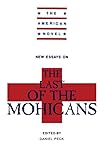New essays on The last of the Mohicans / edited by H. Daniel Peck.
Material type: TextSeries: The American novelPublication details: Cambridge [England] ; New York : Cambridge University Press, 1992.Description: viii, 143 p. ; 23 cmISBN:
TextSeries: The American novelPublication details: Cambridge [England] ; New York : Cambridge University Press, 1992.Description: viii, 143 p. ; 23 cmISBN: - 0521377714 (paperback)
- 0521374146 (hardback)
- PS1408 .N48 1992
| Item type | Current library | Call number | Copy number | Status | Date due | Barcode |
|---|---|---|---|---|---|---|
 General Books
General Books
|
CUTN Central Library Literature | 813.2 (Browse shelf(Opens below)) | 1 | Available | 9407 |
Includes bibliographical references (p. 141-143).
The American Novel series provides students of American literature with introductory critical guides to the greatest works of American fiction. Each volume begins with a substantial introduction by a distinguished authority on the text, giving details of the novel's composition, publication history and contemporary reception, as well as a survey of major critical trends and readings from first publication to the present. This overview is followed by a group of new essays, each specially commissioned from a leading scholar in the field, which together constitute a forum of interpretative methods and prominent contemporary ideas on the text. There are also helpful guides to further reading. Specifically designed for undergraduates, the series will be a powerful resource for any one engaged in the critical analysis of major American novels. The Last of the Mohicans is the most widely read and internationally acclaimed of James Fenimore Cooper's Leatherstocking tales, and has traditionally been regarded as an exciting and well-made adventure story. In recent years, however, critics have found in this classic tale of colonial warfare deeper levels of meaning. In the introduction to this volume, H. Daniel Peck studies these developments, tracking critical responses to the novel from the time of its publication in 1826 to the present day. The essays that follow present contemporary reassessments of The Last of the Mohicans from a variety of critical perspectives. Wayne Franklin shows how Cooper's depiction of Glens Falls--the site of one of the novel's key scenes--represents the process by which the writer dreams his way into the American past. Terence Martin examines the novel's great pivotal episode, the massacre at Fort William Henry revealing how this specifically historical event marginalizes and displaces even the heroic Uncas and Natty Bumppo, thus replicating the very force of history. Nina Baym positions the novel, critically, between the works of two women writers of the 1820s, Lydia Maria Child and Catherine Maria Sedgwick, showing how their women-centered narratives implicitly challenge Cooper's assumptions about sexual, racial, and social roles. Shirley Samuels, combining feminist and new historicist approaches, considers the theme of cultural miscegenation and demonstrates how the novel's pervasive confusions of identity dramatize an intense fear of women and of natural reproduction. Finally Robert Lawson-Peebles shows how the carnage of the massacre of Fort William Henry may be understood as a violation of European theories of warfare, and how this violation reveals Cooper's attitudes toward the New World environment.


There are no comments on this title.